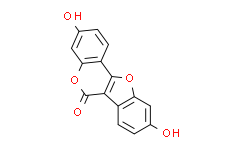| Cas No.: | 479-13-0 |
| Chemical Name: | 6H-Benzofuro[3,2-c][1]benzopyran-6-one,3,9-dihydroxy- |
| Synonyms: | 6H-Benzofuro[3,2-c][1]benzopyran-6-one,3,9-dihydroxy-;Coumestrol;3,9-dihydroxy-[1]benzofuro[3,2-c]chromen-6-one;3,9-Dihydroxy-6H-[1]benzofuro[3,2-c]chromen-6-one;COUMESTROL(RG) PrintBack;3,9-Dihydroxycoumestan;7,12-Dihydroxycoumestan;coumesterol;Cumoesterol;Cumoestrol;Cumostrol;[ "" ] |
| SMILES: | OC1=CC2=C(C=C1)C3=C(O2)C4C(=CC(O)=CC=4)OC3=O |
| Formula: | C15H8O5 |
| M.Wt: | 268.22102 |
| Purity: | >98% |
| Sotrage: | 2 years -20°C Powder, 2 weeks 4°C in DMSO, 6 months -80°C in DMSO |
| Description: | Coumestrol, a phytoestrogen present in soybean products, exhibits activities against cancers, neurological disorders, and autoimmune diseases. It suppresses proliferation of ES2 cells with an IC50 of 50 μM. |
| Target: | IC50: 50 μM[1] |
| In Vitro: | Coumestrol exerts chemotherapeutic effects via PI3K and ERK1/2 MAPK pathways. Coumestrol inhibits viability and invasion, and induces apoptosis of ES2 (clear cell-/serous carcinoma origin) cells. In addition, immunoreactive PCNA and ERBB2, markers of proliferation of ovarian carcinoma, are attenuated in their expression in coumestrol-induced death of ES2 cells. Phosphorylation of AKT, p70S6K, ERK1/2, JNK1/2 and p90RSK is inactivated by coumestrol treatment in a dose- and time-dependent manner[1]. Coumestrol inhibits proliferation and induces apoptosis in MCF-7 cells, which is prevented by copper chelator neocuproine and ROS scavengers. Coumestrol treatment induces ROS generation coupled to DNA fragmentation, up-regulation of p53/p21, cell cycle arrest at G1/S phase, mitochondrial membrane depolarization and caspases 9/3 activation[2]. |
| Cell Assay: | To determine dose-dependent effects of coumestrol, ES2 cells are treated with different concentrations (0, 1, 10, 20, 50 or 100 μM) of coumestrol[1]. Coumestrol is dissolved in DMSO to prepare a 3 mM stock. Breast cancer MCF-7 cells are treated with increasing concentrations of coumestrol for 24, 48 and 72 h. Then, 20 μL of MTT (5 mg/mL) is added each well and re-incubated for additional 3 h. Formazan blue crystals formed are dissolved in 100 μL of DMSO. Absorbance is read at 570 nm using ELISA plate reader[2]. |
| References: | [1]. Lim W, et al. Coumestrol suppresses proliferation of ES2 human epithelial ovarian cancer cells. J Endocrinol. 2016 Mar;228(3):149-60. [2]. Zafar A, et al. Cytotoxic activity of soy phytoestrogen coumestrol against human breast cancer MCF-7 cells: Insights into the molecular mechanism. Food Chem Toxicol. 2017 Jan;99:149-161. |

 To enhance service speed and avoid tariff delays, we've opened a US warehouse. All US orders ship directly from our US facility.
To enhance service speed and avoid tariff delays, we've opened a US warehouse. All US orders ship directly from our US facility.




















